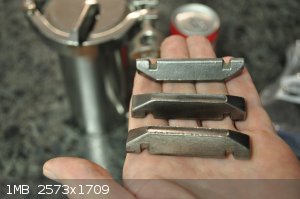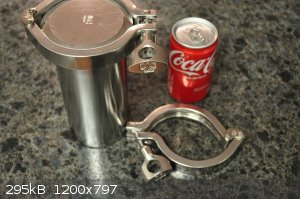Morgan
International Hazard
    
Posts: 1694
Registered: 28-12-2010
Member Is Offline
Mood: No Mood
|
|
Lighting solid steel on fire with a propane torch
So I was strongly heating one of the segments from this pipe expander that was broken and after a minute or so it started smoking. The torch was your
basic propane torch with the wider big flame for soldering copper pipes. Then I noticed some flames and removed it from the flame and it stayed lit.
The metal is strongly attracted to a magnet and it must have an oil or something impregnated in it like some bronze metal perhaps?
The same thing happened to me when I strongly heated a wingnut from a sanitary tri clover clamp. It actually will stay lit for a time in open air if
STRONGLY heated. The metal isn't burning but whatever is degassing from it does.
With the pipe expander steel segment I could see at one end a kind of steam/exudate like wet log in a fire where the ends have been sawed. It's just a
strange thing to behold. At first I thought well maybe they has some oil on them but that would have burned off long before because the torch flame
really blasted the metal for some time before the effect started. And the tri clover part was pristine to start.
Although not related it brought to mind palladium loaded up with hydrogen.
From a 2011 SM post ...
"When a strip of palladium foil, or a thin palladium wire, is fully charged with hydrogen in this way, a slight elevation of temperature suffices to
expel a little of the occluded gas; in consequence the charged metal can be used as a candle or torch; when the end is held for a moment to a light
the heat expels some of the hydrogen, which takes fire and burns ; the heat thus produced causes more hydrogen to be liberated, so that the flame
keeps burning for some time, the metal being clothed with a very pale flame, almost invisible in daylight, somewhat as though it had been dipped in
strong alcohol, and then fired before the spirit evaporated."
These examples/culprits
https://www.harborfreight.com/media/catalog/product/cache/9f...
https://cdn11.bigcommerce.com/s-6ibox/images/stencil/700x700...
[Edited on 29-1-2024 by Morgan]
|
|
|
Morgan
International Hazard
    
Posts: 1694
Registered: 28-12-2010
Member Is Offline
Mood: No Mood
|
|
It occurs to me both the parts shown, the pipe expander and tri-clover wingnut might have had to be made of steel to be strong and yet the somewhat
intricate nature of the shape may have been best arrived at/cheaper by sintering powdered metals where oil could have been introduced?
It was like mother of god what is happening with this metal which would never stop smoking and then catching fire.
|
|
|
Rainwater
National Hazard
   
Posts: 919
Registered: 22-12-2021
Member Is Offline
Mood: indisposition to activity
|
|
Weighing a sample and comparing it to a density chart will be difficult without knowing they alloy. Sintered metals have much less density than forged
parts. Much less strength too, that expander block should be made from solid forged steel, if that broken segment was sintered, you got yourself a
cheap knockoff off. By studying the broken piece, under a stress fracture, solid steal will be smoth and shiny, like glass, sintered metals will be
rough and granny. Anyway, if its sintered, it likly absorbed oil and grease during use.
"You can't do that" - challenge accepted
|
|
|
Morgan
International Hazard
    
Posts: 1694
Registered: 28-12-2010
Member Is Offline
Mood: No Mood
|
|
The expander I bought new never had any grease put on it, the black O-rings broke that hold the ribs together but I saved the parts. Perhaps they were
hydraulically pressed, then fired, and tumble polished. Or maybe they were cast. Whatever the case they are strangely flammable. Here's another
perspective of them. Somehow they are loaded with oil that hisses out of them after strongly heating them, somehow they must be porous.
https://www.youtube.com/watch?v=bcuMOuMk9Ko
"for use with mild and aluminized steel pipes"
https://www.youtube.com/watch?v=Z_XhvIsV1c4
The flammable tri-clover nuts don't look it here/poor lighting but the patina has a bright white new look to them and a pic of the expander ribs.


[Edited on 30-1-2024 by Morgan]
|
|
|
Mateo_swe
National Hazard
   
Posts: 541
Registered: 24-8-2019
Location: Within EU
Member Is Offline
|
|
Stainless steel burns if hot enough and burns good if oxygen is supplied.
We have some thermal lances lying in our garage, leftovers from a company my father had who made alarms for bank vaults and safes.
Its basicly a stainless steel long pipe with some smaller solid core stainless steel wires inside the pipe.
In the back end one connects a regulator that goes to an oxygen tank.
These thermal lances were used to test alarms when attack attempts were made on the bank vault doors.
The oxygen were turned on and the end of the lance was set on fire with a high temp torch (stainless steel burns when hot enough and especially when
fed pure oxygen).
The burning lance was then pushed right through the bank vault door with molten metal pouring out of the hole, quite cool.
A bank vault door is thick, like over half a meter or something similar.
So stainless steel can indeed be set on fire and can be used to make a hole in such a vault door.
One will set the alarms off though.
|
|
|
Morgan
International Hazard
    
Posts: 1694
Registered: 28-12-2010
Member Is Offline
Mood: No Mood
|
|
Maybe my flammable metal was formed with some sort of sealant.
https://www.sharrettsplating.com/additional-services/vacuum-...
|
|
|
yobbo II
National Hazard
   
Posts: 762
Registered: 28-3-2016
Member Is Offline
Mood: No Mood
|
|
."Stainless steel burns if hot enough and burns good if oxygen is suppliedu)"
There are many different types of ss.
Some will not burn.
What tyre of ss would it be?
Low Cr. no Ni? (Guess)
Neighbour down the road has a great big safe..............
[Edited on 26-4-2024 by yobbo II]
|
|
|
clearly_not_atara
International Hazard
    
Posts: 2786
Registered: 3-11-2013
Member Is Offline
Mood: Big
|
|
Usually iron and its alloys are resistant to fire because the specific enthalpy of combustion is not high enough to vaporize metal and produce the
fuel-air mixture needed for a flame. But air entrained in a sintered component could change that.
|
|
|
chornedsnorkack
National Hazard
   
Posts: 563
Registered: 16-2-2012
Member Is Offline
Mood: No Mood
|
|
Quote: Originally posted by clearly_not_atara  | | Usually iron and its alloys are resistant to fire because the specific enthalpy of combustion is not high enough to vaporize metal and produce the
fuel-air mixture needed for a flame. |
Does carbon burn?
It sublimes at 3600 degrees and the vapour pressure is quoted as 1 decibar at 3300 degrees, 1 centibar at 3000 degrees. Does combustion of carbon in
air (remember to heat the nitrogen) produce enough heat to vaporize carbon?
|
|
|
Morgan
International Hazard
    
Posts: 1694
Registered: 28-12-2010
Member Is Offline
Mood: No Mood
|
|
When my strongly heated metal parts became a uniform dull red they would catch fire and burn or sustain much like a gentle oil candle flame for
several seconds. Before this they would start to smoke and degas so I kept heating them to try to completely rid them of whatever it was. The metal
itself isn't burning per se or no bright white light.
It could be some of the binders or lubricants react somewhat with the metal when initially sintered at the factory or that some binder or lubricant
doesn't get cooked out of it completely.
Forming Processes- Powder Metallurgy
https://www.youtube.com/watch?v=NZCu1-roopk
|
|
|
Morgan
International Hazard
    
Posts: 1694
Registered: 28-12-2010
Member Is Offline
Mood: No Mood
|
|
Maybe the extreme heating of my two metal parts (pictured in a previous post above) drove off the last of some residual substance to cause them to
first start smoking and then further over a long period of direct heating with a propane torch, eventually flame when red hot, with the torch removed.
"Residual fluids are another problem for powder metal parts. Fluids can become trapped within the pores of the piece, which can then lead to unwanted
damage or hazardous conditions down the line. During sintering, water vapor may become trapped within the part. If this occurs, it can cause internal
rusting depending on the metal the part is made out of. And during quenching, the quench media, typically an oil, can also become trapped. If this
happens, it can lead to the oil within the part igniting during post-quenching heat treatments such as tempering. It is important to draw these fluids
out of the piece before performing additional heat treatments."
"When tempering a powder metal part after quenching has taken place, residual oil within the part is the primary concern. If there is residual oil
inside the pores, it can lead to hazardous fumes, smoke, and fire. But, despite these hazards, tempering is a vital part of the manufacturing process
for many powder metal pieces."
Sintering Porous Powder Metal Parts
https://llfurnace.com/blog/sintering-porous-powder-metal-par...
[Edited on 27-4-2024 by Morgan]
|
|
|
Fantasma4500
International Hazard
    
Posts: 1681
Registered: 12-12-2012
Location: Dysrope (aka europe)
Member Is Offline
Mood: dangerously practical
|
|
as a metalworker, i would say its probably zinc coated, which burns with a bluish green flame and the metal oxide is yellow, thats easy to test by
dipping it in HCl, zinc reacts rapidly
even when i cut through.... 500mm thick steel, manganese alloy as well it didnt burn just by laying around in the air, and that would be boiling steel
puddle, it just glowed and cooled down
which pure oxygen steel does burn, and stainless does as well. i find it hard to believe stainless steel wires are put into these lances? usually
thats some magnesium alloy rather- although welding stainless its known that if you overheat it, the back side will bubble up a lot, it produces a
dark oxide which could imply nickel oxide
maybe its a high-nickel alloy stainless?
|
|
|